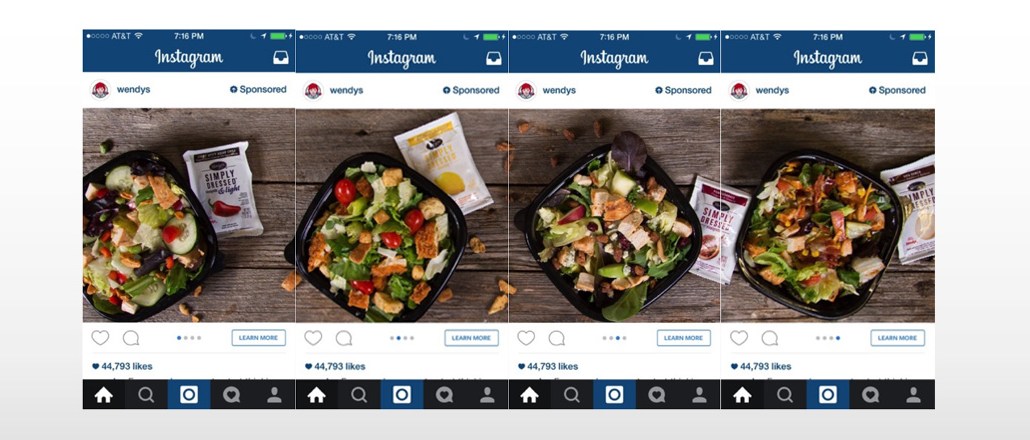
Carousel ads are 10 times better at getting people to click through compared to static sponsored posts on Facebook, according to a new report.
The carousel ads, which let brands show multiple images and ultimately a link to some action, are driving 10 times more traffic to advertisers’ websites, according to data compiled by Kinetic Social, a social marketing tech firm. The report looked at ad trends over the past three months, according to the campaigns that pass through its platform.
“Carousels are a major push for Facebook,” said Don Mathis, CEO of Kinetic Social, which helps brands market across social channels like Facebook, Pinterest, Instagram and Twitter. “The pricing is competitive and the performances are stellar. But we don’t know if that continues forever, because it’s a new product, and they tend to get good adoption in the early days.”
For now, though, 1 percent of users are clicking through on carousel ads compared to 0.1 percent on non-carousel ads, Kinetic said. That’s far better than the rate for a typical display advertisement.
EMarketer has said that the best mobile banner ads — ones from sectors like retail that generate the highest responses from consumers — garner a 0.5 percent click through rate.
The Kinetic Social data is another sign of the growing strength of Facebook’s ad business, particularly since the carousel format is native to mobile. Meanwhile, most publishers are still trying to figure out how to make mobile banners work while simultaneously dealing with the specter of ad blocking.
More brands are moving into carousel formats on Facebook and Instagram. Kinetic Social said it was too early to release what it’s finding about the Instagram ones, but Wendy’s is among the brands that have seen some early success, according to its agency VML.
VML shared one carousel campaign from Wendy’s that ran on Instagram, and the agency said it led to a 20 point lift in ad recall versus a 14 point lift from single-image ads. The point lift means that users who saw the carousel ads were 20 percent more likely to remember the campaign compared to people not exposed to the format.
VML’s Chad Martin said that clients are finding success with a formula that serves one ad on Instagram and then a carousel ad on Facebook. The strategy is particularly effective when they hit up Facebook users with a carousel after they’ve already shown interest in its brands.
“We can tell if they’re engaged heavily on Instagram and retarget on Facebook with carousel ads,” said Martin, VML’s director of social and emerging media. “The ads allow for more of a conversation than a quick flyby.”
Kinetic is one of many social marketing technology players that plug into the platforms for automated ad buying, and the measurements from each can vary.
Kinetic also looked at video ads for the past quarter, and found that autoplay, ones that start without clicks, perform better on mobile devices than desktop.
Autoplay videos in Facebook’s mobile News Feed have higher click-through rates and lower costs than desktop, Kinetic’s report said.
It also found that shorter videos — those in the 15- to 30-second range — have higher completion rates. The length of the creative is an important measure for the creative community, wrestling with what works best on digital video, according to Martin.
“That means, OK, we’ve got 15 seconds or 12 seconds or whatever it is to tell a story,” Martin said. “So you have to be precise.”
Brands and agencies are tweaking their creative templates to fit the platforms, like telling brand messages without sound, because autoplay video is mute. Or they get to the point in 3 seconds or less to account for fast-scrolling.
Martin said brands shouldn’t be repurposing straight TV content for the digital video, either, something that too many brands often do and expect good results.
Kinetic Social also looked at Twitter’s numbers for the quarter and said that costs on video are coming down on that platform as it matures its offering. Cost per view on videos averaged 10 cents with some verticals as low as 5 cents, putting it on par with Facebook costs, Kinetic said.
Costs per engagement fell almost 50 percent for Twitter advertisers, too. They were paying 23 cents for every click on their ads on Twitter versus 45 cents a year ago, according to Kinetic’s stats.
Image courtesy of VML and Wendy’s.
More in Media

WTF is behind the explosion of faceless creators?
Brands are rapidly increasing their spending on faceless creators, showing the unique benefits of working with this type of influencer.

In Graphic Detail: As ‘Grow a Garden’ booms, a new report shows the marketing power of Roblox
The explosive growth of “Grow a Garden” has brought new attention to Roblox — and rejuvenated marketers’ interest in its advertising power.

Brand deals surge for golf creators as the sport’s popularity spikes
Golf is booming, and so is influencer marketing. As a result, golf creators are signing an unprecedented number of brand deals in 2025.





